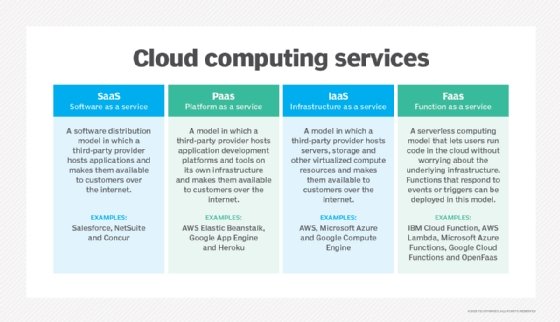application service provider (ASP)
What is an application service provider?
An application service provider (ASP) is a company that offers individuals or enterprises access to applications and related services over the internet. The term has largely been replaced by software as a service (SaaS) provider, although in some parts of the world, companies still use the two labels interchangeably.
ASP services were at one time called "apps on tap." They were an important alternative for individuals and smaller companies with low budgets for information technology (IT) and also for larger companies exploring the idea of outsourcing their IT infrastructure around the turn of the century.
Early ASPs focused on delivering specialized applications that were expensive to install and maintain. Essentially, the model required the ASP customer to purchase the software and then pay a provider to host it.
In 1999, Hewlett-Packard, SAP and Qwest Communications International Inc. formed the Application Service Provider Industry Consortium (ASPIC), a group representing ASP service providers. HP, SAP and Qwest teamed up to make SAP's popular R/3 applications available at "cybercenters" that would serve the applications to other companies. Around the same time, Microsoft allowed some companies to offer its BackOffice products, including SQL Server, Exchange and Windows NT Server, on a rental, pay-as-you-use basis.
ASPs provided applications and services to small enterprises and individuals on a pay-per-use or annual license fee basis. Meantime, larger organizations provided their own in-house ASP service, moving applications off personal computers (PCs) and putting them on a special kind of Application Server that was designed to work with thin client workstations. This approach enabled enterprises to return to the more centralized control over application costs and use that they had in the period prior to the advent of the PC.
How do ASPs work?
ASPs delivered applications via the internet or a private network. Clients were charged one of four ways:
- a usage-based fee structure;
- a fee based on features;
- a flat monthly or annual fee; or
- a combination of these previous three.
Those fees covered hosting, maintenance and support. In this model, ASPs provided a specific environment for each client and did not share that environment with other clients. This single-tenancy approach ensured security and continuity of operations.
The ASP definition was somewhat fluid in the late 1990s and early 2000s. Many early ASPs offered only their own applications. Other ASPs hosted and repackaged multiple third-party applications, many of them simple collaborative tools. However, a near collapse of the ASP market in the early 2000s led surviving ASPs to offer more integrated applications and to rebrand or reimagine themselves as managed service providers (MSPs), web service providers or application infrastructure providers.
Eventually, the market gave way to the SaaS and platform as a service (PaaS) models. Both the SaaS and PaaS models typically offer a mix of proprietary and third-party offerings.

Advantages and disadvantages of the ASP model
The ASP approach comes with several advantages and disadvantages, including the following:
ASP advantages
- Costs. The customer, in theory, would not need to hire a large IT staff because the ASP would handle much of the work. Customers also could shift costs from capital to operating expenditures, which was attractive to some customers for accounting reasons.
- Deployment. Faster rollout is possible, because the back end of the application is already up and running.
- Upgrades. As part of their service contract, ASPs could track and push software upgrades, freeing customers of that task.
- Service-level agreements (SLAs). These agreements are tailored to specific customers.
ASP disadvantages
- Costs. In a single-tenant environment, applications that a customer purchased or leased are walled off from other customers' applications. As a result, there are no economies of scale. So, costs do not fall as ASPs take on more customers.
- Security. Because most ASP customers were SMBs, ASPs offered them virtual servers, rather than dedicated servers. The real security risks of this were debated, but the appearance of security risk hurt the early ASP market.
- Lack of integration. Early ASPs did offer software suites, but a lack of integration with customers' legacy software also hurt the early ASP market.
Differences between ASP and SaaS delivery models
There are a number of differences between the ASP delivery model and SaaS. In an ASP delivery model, the customer typically purchases software and pays an ASP to host and maintain it. SaaS vendors manage software they have developed on their own or, in many cases, offer both their own applications and those developed by third parties.
Traditional ASPs used a single-tenant architecture and software clients had to be installed on the end users' computers. In contrast, SaaS providers use a multi-tenant architecture, and an application is accessed through a web browser and serves multiple users and businesses.
Today, ASPs are not used much. Customers who need providers that will host specific, customized applications or off-the-shelf applications in a secure data center, may choose to look for an application service provider.
Types of application service providers
ASPs are divided into categories depending on the type of applications they provide or the customer base they serve. The five common types of application service providers are the following:
- Local or regional. Focuses on the needs of businesses in a specific local or regional area.
- Specialist. Provides one type of application or service to meet a business's needs in a specific area, such as e-commerce management.
- Vertical market. Hosts applications to meet the needs of a business in a specific industry -- such as a law practice of a healthcare provider.
- Enterprise. Has a range of business applications for larger businesses, such as enterprise resource planning (ERP) software.
- Volume. Offers a low-cost prepackaged set of applications.
Application service provider examples
As mentioned earlier, ASPs generally have been replaced by SaaS providers. Some examples of ASPs include the HP, SAP and Qwest alliance discussed earlier, as well as the following:
Corio was founded in 1998 and provided a suite of enterprise applications. It bought the ASP assets of Qwest CyberSolutions LLC, a subsidiary of Qwest Communications in 2002. IBM then bought Corio in 2005.
DoubleClick provided ad-serving services to publishers, marketers and agencies. It was founded in 1995, and Google bought DoubleClick in 2008.
FutureLink, another short-lived company, was founded in 1998. It was also a founding member of the ASPIC, and it offered applications from Great Plains, Microsoft, Onyx, Pivotal and Sales Logix for monthly subscription fees. FutureLink shut down in 2001.
Pandesic was an early ASP, formed out of a 1997 joint venture between SAP and Intel. It offered an e-commerce management application. It was out of business by July 2000.
ASP is also an abbreviation for Active Server Page.
Enterprises today are focused on how to make the best use of SaaS as they move more of their applications and workloads to the cloud. Find out the latest thinking in this look at SaaS vs. IaaS cloud models.








